How to install Windows windows on a laptop. Practical tips on how to install windows xp on a laptop
Sometimes it becomes necessary to reinstall the Operating System (OS) on your laptop (computer). This can be for a variety of reasons: New laptop, completed without an OS to reduce its cost, the defeat of the system by viruses, the replacement of the OS with another (newer or vice versa - the old one used to it).
This article will help you install the OS on your laptop yourself!
It should also be noted that this article is intended for installation from disc, that is, for laptops that have an optical CD / DVD drive. For devices that do not have such a drive (netbooks), this instruction is suitable only if an external drive is connected to the device, if USB help, for example.
So, let's begin:
First of all, we need to say about what we need. We only need a disk with the Windows OS distribution kit (preferably "clean", that is, NOT "assembly"). The recorded disc must be "bootable". That is, if you just rewrite, somewhere downloaded, Windows to disk - you will not succeed. How to burn a "bootable disk" with Windows will be discussed in another article. If it is interesting - ask in the comments - I will help you.
Let's get back to our problem. We believe that we have a Windows disc properly and correctly burned!
Then I will write in stages, with maximum comments on the stages (I remind you that it will not be clear, you can always clarify in the comments to this article).
1. Turn on your laptop.
2. Immediately after turning on, press the "F2" key (in some laptops this may be the "Delete" key or another, see the instructions for the laptop) to enter the BIOS (no need to be afraid of this word, but unnecessary experiments in the BIOS are also better for now not to do).
3. Insert the Windows disc into the laptop's optical drive (press the drive deck open button). Close the disc deck.
4. In the BIOS, go to the “Boot” tab (you can do this using the navigation arrows on your keyboard).
5. On the “Boot” tab, you need to find a parameter that is responsible for the sequence of devices from which the OS will boot. Most likely, it will be called "Device from boot", or something like that.
6. Install your optical drive (CDROM) in the first place in the download. This can be done in different ways depending on the BIOS version. In some BIOSes, this is done using the "F5" or "F6" keys (there are hints on the right side of the BIOS, albeit in English) - select CDROM and press the key until CDROM is at the very top in the first place. In some of them you will select the line with the first place with the "Enter" key and then select the device you need from the list (do not forget, this device is our optical drive with a CDROM disc). By the way, in the latter case, I would recommend leaving CDROM in the first place, and choosing the “Disabled” option for all the rest. Don't worry, after installation we will return everything as it was.
7. Press the "F10" key, agree with the changes made, that is, press "Enter". Reboot started.
8. After rebooting, do not miss the moment when the laptop prompts you to agree to boot from the disk. An inscription will appear on the screen, for example "Boot from cdrom press any key" (to boot from a disk, press any key) and several dots. Quickly press "Enter", space or any other key. Boot started from the disc inserted into our drive.
9. After a couple of minutes, information will appear with the available sections at our disposal hard disk(This will be "Partition C, D", etc., by the way, there can be only one partition, which will mean about non-partitioning of the disk into partitions, which is not correct, and we will solve it).
10. Formatting Partition C. Depending on the version of Windows, this is done with minor differences.
In Windows XP, we need to select (with the keyboard navigation arrows) Partition C and delete it by pressing the "D" key (follow the prompts on the monitor), confirm the deletion with the "L" key. An "unallocated area" will appear in the main window with sections. We select this area and create the section again by pressing the "C" key. For the proposed amount of allocated memory, we collect 40,000 (40GB) or as much as you think is necessary. You can also leave the amount that is offered by default if you already have other Sections (disk D, E, etc.). If they are not there, then in a similar way you can create the quantity you need with the dimensions you need. After partitioning the disks, select "Partition C" and press "Enter". Formatting the Section into file system NTFS or FAT32 (I think FAT32 is the best option for Windows XP). Has gone Windows installation to drive C.
Windows 7 is slightly different, but the meaning is the same. Following the prompts, we can delete, create, format any partition on the hard drive. Then select "Section C" and press "Enter". If you need to explain this point in more detail - write in the comments - I will definitely help you.
11. During installation, the laptop will offer to set the time, select a language, come up with a name laptop... I think you can handle this without unnecessary help. One thing that I recommend that you do not rush to assign an Administrator password (you can always manage to do this directly from the OS installed), and also refuse to update and register via the Internet.
12. After about 30-40 minutes, the OS will be installed, and you will see a brand new, just-born Windows in front of you.
13. Return to the BIOS again (how to do this is described in point 2) and install our own instead of CDROM HDD most likely it will be its name: Samsung, Seagete, Hitachi, etc., with the designation of its markings. We press "F10" and "Enter". We reboot and boot from the hard disk (you can get the disk from the drive).
Of course, after installing the OS, you will also need to install drivers, various programs, etc., but this will be considered in other articles.
Thank you for the attention!
P.S. The article can be supplemented or edited, based on the recommendations in the comments, as well as when answering questions in the same comments.
There is a lot of controversy online - which is better? Windows 8 or Windows 7
Each person has their own opinion. It's better for me seven(easier to navigate), some of my friends like eight... But if you are reading this, then you have decided to replace Windows 8 with Windows 7.
Where do we start? Since the installation of the system? NO! With preparation bios and hard drive.
You can't boot from disk to start install windows.
All modern laptops and computers bios has a UEFI boot system.
What is UEFI? Help from Microsoft.
UEFI (Uniform EFI) is a standard firmware interface for computers that replaces BIOS. More than 140 technology companies that are part of the UEFI consortium, including Microsoft, contributed to the creation of this standard. The standard was created to improve interoperability software and removing BIOS limitations.
Note.
All 64-bit computers running Windows control with the logo, Windows certification programs use UEFI instead of BIOS.
To boot from a disk or bootable flash drive, we need to change some BIOS settings.
The bios graphical shell is different - but the settings are the same.
1.) In BIOS UEFI we find and disable the item Secure Boot... Set it to Disabled
Disabled - disabled.
Enabled - enabled.
2.) open item item System configuration, it should be on the tab Advanced... Looking for an item Boot Mode and set the value opposite to it CSM Boot, or UEFI and Legacy OS, could still be CMS OS.
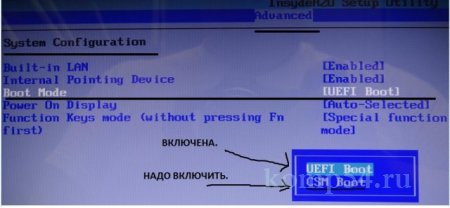
Press F10 (save and exit)
We can now boot from third party media. But it's too early to install the system .(The installer won't let you anyway)
We need to deal with the hard drive.
Everything hard drives in modern laptops and computers in the format GPT... We need a format MBR.
GPT is a standard for formatting partition tables on a physical hard disk. It is part of the Extensible Firmware Interface (EFI), a standard proposed by Intel to replace the BIOS. EFI uses GPT where the BIOS uses the Master Boot Record (MBR).
Unlike MBR, which starts with an executable binary program to identify and load the active partition, GPT relies on advanced EFI capabilities to perform these processes.
The best program in my opinion for this is Paragon Hard Disk Manager
Loading with and launching Paragon Hard Disk Manager
ATTENTION:
Until you remove all service sections, you can't convert GPT to MBR.
(I personally delete all partitions, create three new ones (for the system, for storing everything you need and for games) and only then I convert
GPT to MBR).
After the done manipulations, you can safely install Windows 7.
Self-installation of Windows 7 made easy
Sooner or later, everyone faces the need to install an operating system on a PC or laptop. Someone, without making any attempts to figure it out, calls a master for this, and someone else decides to do everything himself and in the end wins - saves money and gains useful experience. Why do some users lack the determination to install Windows? Most likely, for fear of breaking something, losing valuable data, or ... because at the right time there was no clear instruction at hand.
Is it difficult to put Windows on your computer yourself? Is it possible during installation to damage the hardware or irrevocably lose information on the hard drive? We answer:
- installing the system is absolutely easy - the installation process of Windows of the latest releases (7 and 8) is as automated as possible and practically does not depend on the user (with the exception of individual user settings);
- the only way to damage the data is by mistakenly formatting the wrong partition where the OS will be installed (at this point we will focus more on it);
- physical breakdown of hardware devices due to OS installation failures - excluded. Even if the electricity is cut off at this time, the only problem will be the need to install Windows again.
Failures during the installation of Windows 7 are rare: in 90% of cases, everything goes smoothly from start to finish. Unlike other types of operating systems, a novice user, who has never dealt with this before, will be able to put the "seven" on a computer. And the instructions we have prepared will help you figure it out.
Preparing to install the "seven"
Most often DVDs and flash drives are used as OS distribution media. A pre-made Windows 7 disc can be purchased in stores, but many users choose to create one themselves.
It doesn't take much to burn the installation CD:
- blank DVD;
- an optical drive on a computer (built-in or external);
- program for burning discs (UltraISO, Nero, etc.);
- distribution kit in * iso format.
You don't need to do anything with the iso file beforehand - it is transferred to the disk as it is.
To prepare you will need:
- the drive itself, with a capacity of 2 Gb or more - depends on the size of the distribution;
- Windows 7 distribution kit in the form of an iso image or on DVD, as in the previous case;
- program for creating installation flash drives, for example, WinSetupFromUSB, Rufus, UltraISO, Windows 7 USB / DVD Download Tool from Microsoft, etc.
Let's look at the procedure for creating an installation USB stick using a tool from Microsoft. It takes place in 4 stages.
- Run the pre-installed Windows utility 7 USB / DVD Download Tool. Specify the location of the "seven" distribution kit (iso file).
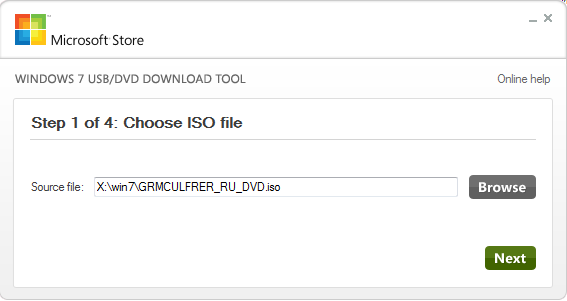
- Select the type of drive (in our case, it is a USB device).

- From the list of available drives, select a USB flash drive of a suitable capacity and click "Begin copying".
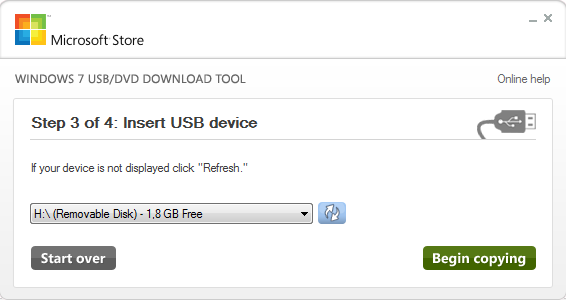
- Wait until the files are copied.

After that, the flash drive will be ready to install Windows.
Installing Windows 7
BIOS setup
Before installing the system, you need to change a little BIOS settings computer - designate a DVD-disk or USB-flash drive as the first bootable device.
To do this, immediately after turning on the computer, you need to hold down the key assigned to enter the BIOS Setup. For different manufacturers, it can be F2, F4, F10, F12, Delete or something else - more precisely, you can find out from the instructions for motherboard or the inscription under the logo of its manufacturer, which first appears on the screen after starting the PC.
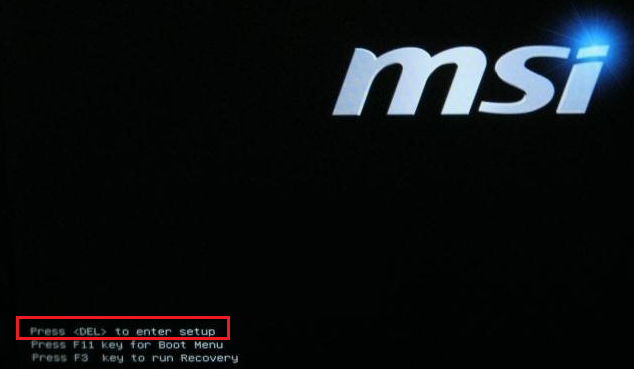

In the console interface of older BIOS versions, as well as on laptops, the keys that are used to navigate and select the desired menu items are indicated at the bottom of the screen.
In the UEFI graphical menu, all operations can be performed using the mouse.
The main part of the installation
Having reconfigured the order of boot devices, proceed to installing Windows. If you are going to install "Windows" from a DVD-disk - mark it in the drive, if from a USB flash drive - connect it to a free port and restart the computer.
After restarting you will see the following picture.
![]()
Everything here is intuitively clear - from the lists on this screen you need to select the language in which your Windows 7 will "speak". Further installation progress and all dialogues will be conducted in the selected language.
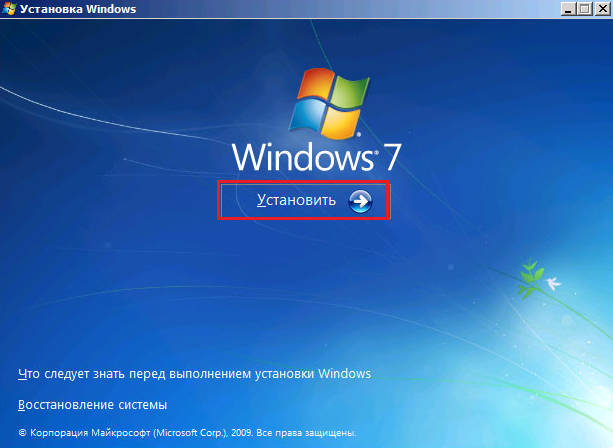
Accept the license agreement.
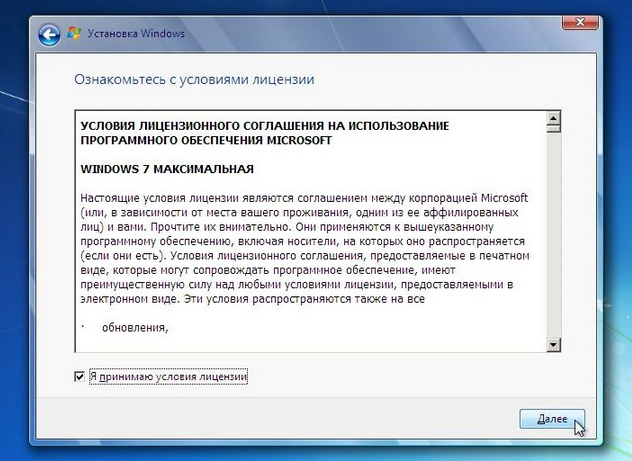
The next window will ask you to choose the type of installation - update or full. The update is available only when a copy of Windows 7 or Vista is already installed on the PC and the installation disk is launched from under it. In all other cases, you must choose a complete (clean) installation.

Next to choose partition hard disk where the Windows installation will be performed. If it is divided into several partitions and some of them store important data, in the course of further actions, be extremely careful: formatting, deleting and breaking partitions into parts will destroy all information on them.
When installing the system on a disk that has an MBR structure (in most cases such disks are used for Windows 7), the system partition must be of the "Primary" type.
Click the Disk Setup button.

Here, using the menu at the bottom of the window, you can control the size of the partitions (shrink and expand), as well as delete them, create new ones and format them.

If you want to completely free the partition where you will install the "Windows", click "Format" and agree to the destruction of all data.

If the information in the system partition needs to be saved, proceed with the installation without formatting. The old copy of the Windows directory will be renamed to Windows.0 and all files on the partition will remain in place.
After choosing a place for Windows installations click the "Next" button.

Now, we can assume that the main work is over. The next step is copying files and installing Windows itself. During this "action" the PC will be rebooted several times without your participation, and after 25-30 minutes the system will notify you of the end of the installation by inviting you to make the initial settings.
Completing the installation and initial configuration
After installation, you will need a little more of your input to make the initial settings. In the first window you need to specify the name account username and computer name.

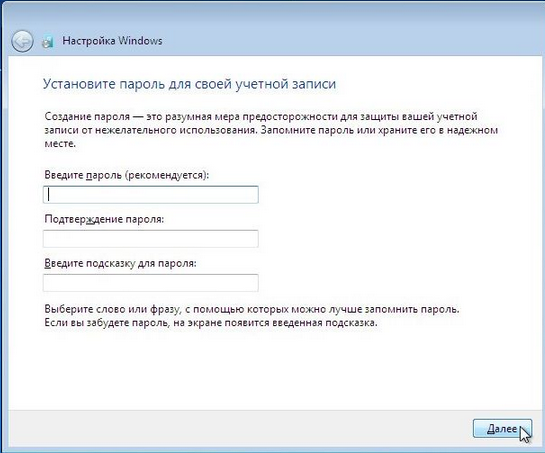
Next, you will be asked to enter your product key. If you do not have it, you can skip this item.
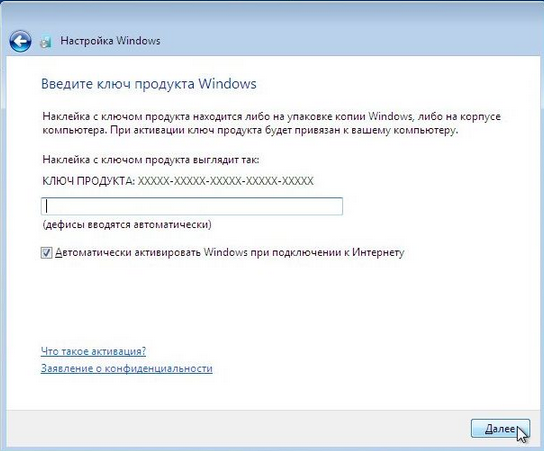
Set security settings.
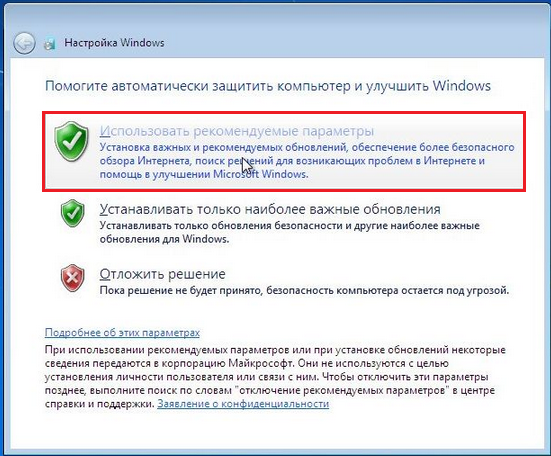
Select time zone, set time and date.

When connected to a network, you can immediately set up your network location. If you install "Windows" on home computer- choose home network... If using a public connection, choose a public one.

After that, it will take a little more time to apply the settings. From the moment the desktop opens, your "seven" is completely ready to work. As you can see, it turned out to be quite easy to put Windows on the computer.

The next mandatory step should be to install the drivers - without them it will not be possible to get "Windows and hardware" to work fully. Next, you need to download and install the Servise Pack 1 update package, install antivirus program and you can fill the "seven" with software.
This guide will show you how to properly install Windows 7 on your computer, laptop or netbook. The issues of activating the operating system, its Russification, installing drivers and utilities will also be considered.
Before proceeding directly to the installation, you need to prepare a disk or flash drive with the Windows 7 distribution.
Preparing for installation
There are two main ways to install Windows 7 on a laptop, netbook, or computer:
1) installation from DVD with Windows 7 distribution kit;
2) installation from a USB flash drive or memory card with Windows 7. This method is suitable for netbooks and laptops without a DVD drive.
To create a DVD or USB flash drive with Windows 7, we need:
1) a distribution kit with Windows 7 in the form .iso image.
2) utility. If you have Windows XP, you need to install a patch for it to work KB932716, and Microsoft. NET Framework 2 .
3) blank DVD or USB stick. A USB card reader with a memory card is also suitable as a flash drive. The size of the flash drive must be at least 4 GB.
Important note: it is highly discouraged to use various Windows assemblies from "craftsmen". It's not at all about the licensed or unlicensed Windows. Not at all. The fact is that the original assemblies from Microsoft are very well tested before release for various errors or flaws. Hardware manufacturers also test their own drivers and software on such assemblies. Some "craftsmen" modify the original distribution, add, modify, and remove some Windows components. How it all works, of course, no one seriously tests. The fact that a certain assembly works well on one laptop or computer does not mean that it will work just as well on another. Problems with such assemblies most often arise during the installation and operation of some drivers. If you want to avoid most of these problems, use the original Windows builds.
Note for Windows 7 versions: original Windows 7 distributions contain all editions of Windows 7 from Home Basic to Ultimate in 32-bit or 64-bit version.
Let's get started. First, you should run the utility Windows 7 USB / DVD Download Tool:
Click on the button Browse and indicate where you have saved the image with Windows 7. Click on the button Next:

Now we choose where to write the Windows 7 distribution kit: to a USB flash drive (button USB Device) or to disk (button DVD). Consider, for example, writing to a USB flash drive:
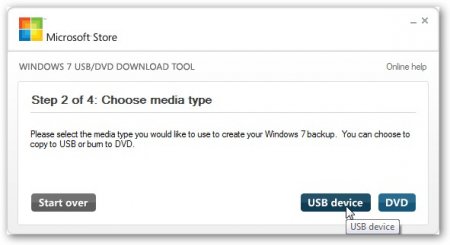
In the window, select your USB flash drive. Before recording, it is worth copying all important information from it, since all the contents of the flash drive will be deleted. .
To start recording, click on the button Begin copying:
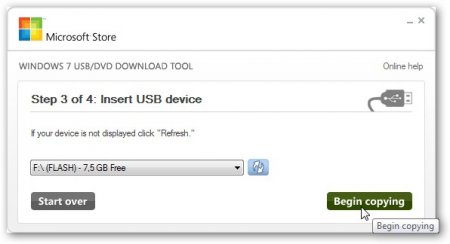
The utility will warn us twice that all data on the flash drive will be erased:
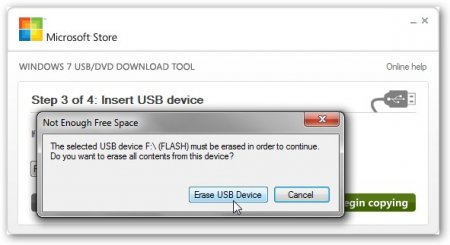

In a couple of minutes you will have a bootable USB stick. If something doesn't work out for you, then this guide: Installing Windows 7 and Windows Vista from a USB flash drive describes two more ways to create such a flash drive.
Writing the distribution kit to disk is the same:

So. The USB flash drive or disk with Windows 7 is ready.
Before proceeding with the installation of Windows 7, you need to make a backup copy of all the necessary information that is located on the C: drive. The fact is that during the installation this section will be formatted and all information on it will be lost.
You can also go the other way, which is described in these materials: and Automatic Windows recovery on a laptop using Acronis True Image. You first make an image of the entire C: drive (that is, all the files that are on the C: drive are packed into one large file), and then, if necessary, you can return everything as it was before installing Windows 7. I also recommend that you familiarize yourself with these materials: and.
Now you can proceed to the installation of Windows 7 itself.
Installing Windows 7
First of all, make sure that the system will boot from a DVD or USB stick. To do this, go to the BIOS (on Acer laptops, Packard bell, eMachines and others, for this you should press the F2 button when loading), then go to the tab Boot and buttons F5 / F6 put your DVD drive or USB flash drive in the first place:

Then go to the tab Exit and select the item Save ...... After that, the laptop or PC must first boot from a DVD or USB flash drive, and then from a hard drive.
Comment: if you install Windows 7 from a USB flash drive, then first you need to connect it, and then turn on the laptop itself, go into the BIOS and set the boot order.
Now you need to insert the disk or USB flash drive into the laptop. When booting, you will be prompted to press any key to start the installation:
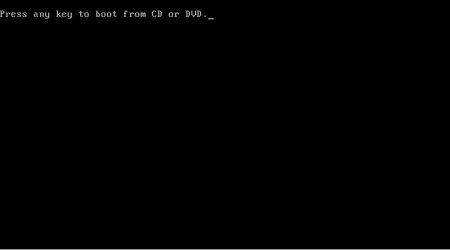
Press any key In a moment, a window like this will appear:


Press the button Install to start the installation.
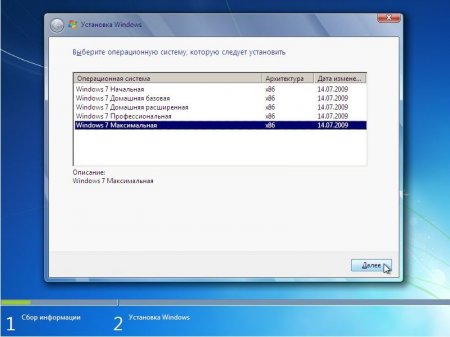
Now you need to select the edition of Windows 7 that you are going to install. It is very important to choose exactly the version that is indicated on the piece of paper with the serial number. If you choose the wrong edition, then there may be problems with activation. When you select the required edition, click Further:
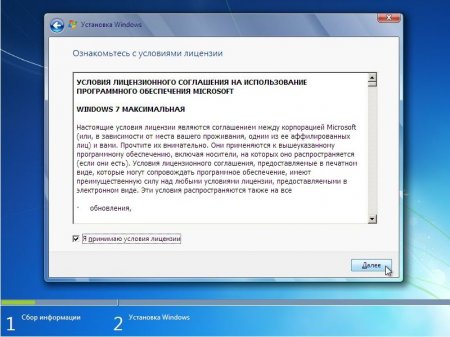
Agree to the License Agreement and click Further:
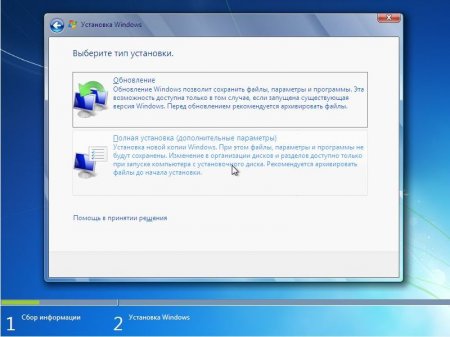
Choose Complete installation.


Note: Acer notebooks have one or two hidden partitions. They are called PQService and ACER. DO NOT PUT Windows 7 on them. More details about these sections are described in these materials: and Working with the automatic installation of Windows on a laptop.
All information from the selected section will be deleted. The installer honestly warns us about this:

Select a formatted section and click Further:

Now it's worth a little wait:

When the installation is complete, you will need to enter a username and computer name:
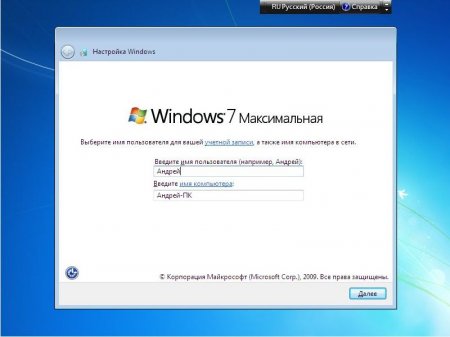

Enter the serial number from a piece of paper on the bottom of the laptop:

The serial number can be omitted. You can use Windows 7 without activation for up to 30 days. This counter can be reset several times.
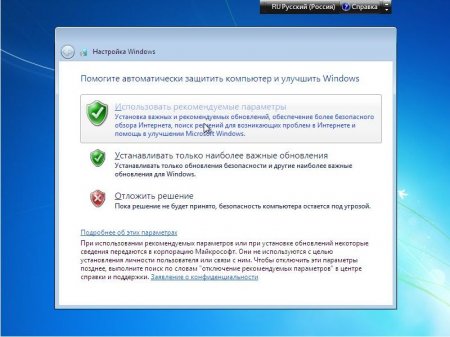
We indicate the time zone, date and time:

If your laptop or computer is connected to a wired network or is in a wireless coverage area, then Windows 7 will prompt you to configure it:

That's all. Windows 7 installed:
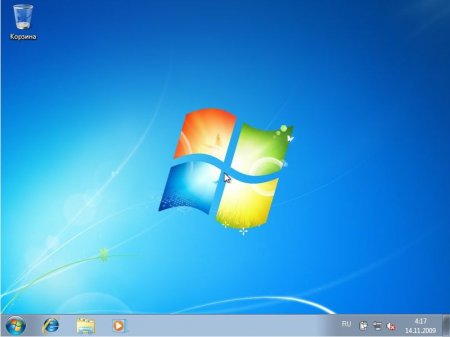
Installing the Russian language
If you installed English Windows version, then you can install the Russian language as well. The ability to install a different language is officially supported in the Corporate and Ultimate editions. For other editions, workarounds need to be found.
Click on Start and go to Control Panel... Selecting an item Change display language:

Go to the tab Keyboards and Languages and click on the button Install / Uninstall languages ...
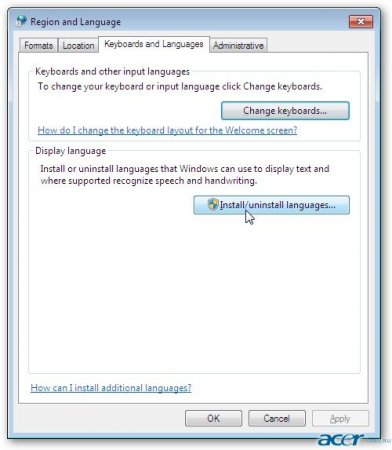
Click on the button Install display languages:
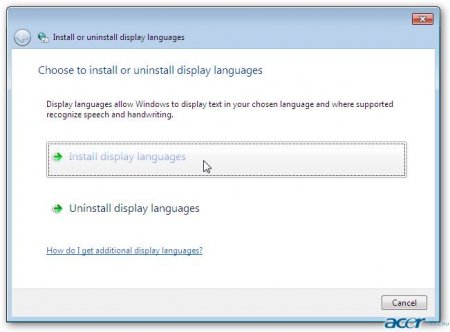
Click on the button Browse computer or network:
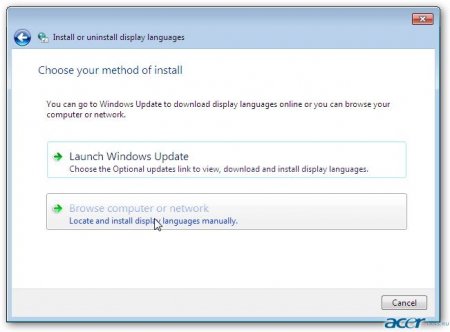
Click on the button Browse and indicate where you saved the file from language pack which was downloaded from these links: download(32-bit) download(64-bit)
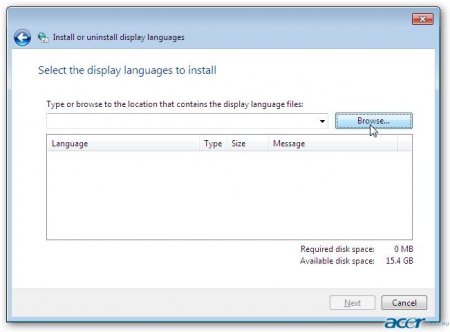
When the file is selected, press the button Next:

We agree to the terms of the license agreement and click Next:

The installation of the language pack should start:
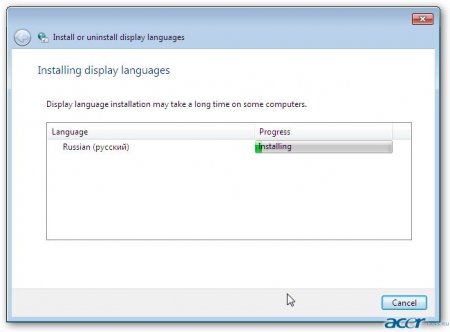
When the installation is complete, click Next:

We choose Russian and click Close:
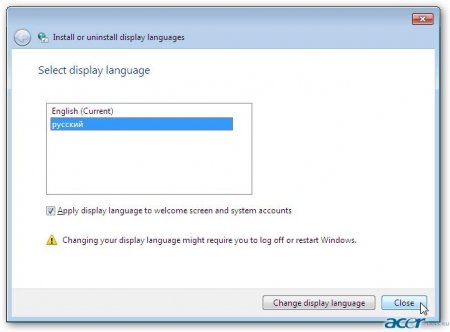
Select in the window Russian and press Apply:

We reboot the laptop or computer. We go back to Languages regional standards and click on Change system language ...
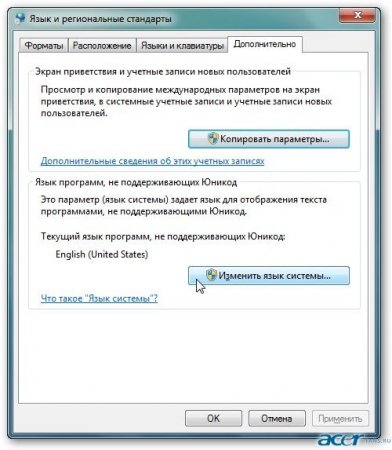
We choose Russian and click OK:
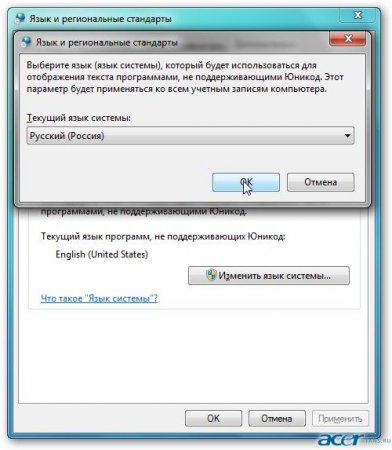
Now the system fully supports the Russian language and fonts
You can also use the service to set a different language. Windows Update
Windows 7 activation
For Windows activation 7 laptop or computer must be connected to the Internet. To start activation, click on the button Start, click on A computer right click mouse and select the item Properties:

Click on 3 days left. ...:

Click on the button Activate Windows over the network:

We are waiting a bit:

As a result, a window like this should appear:
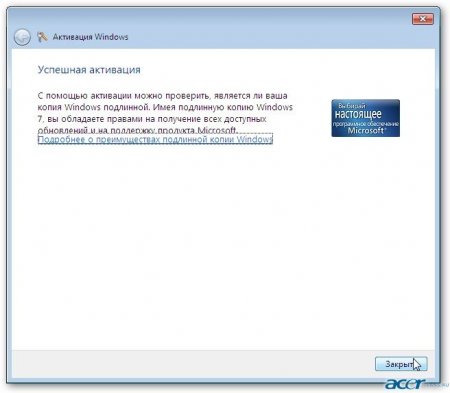
This indicates that your copy of Windows 7 is completely legal.
Installing drivers on Windows 7
You can find drivers for Windows 7 on this site using
The drivers on this site are constantly updated
How to install drivers is described in this material:
1. Chipset
2. Video card
3. Sound card
4. Card reader
5. Wi-Fi and Ethernet adapters
6. Other drivers
7. Drivers for touchpad and Launch Manager.
I will dwell in more detail on the driver for the touchpad (responsible for the touchpad and touch buttons) and Launch Manager (responsible for additional buttons, volume control, etc.).
To install a driver for Synaptics touchpad, you need to run the installer with Administrator rights:
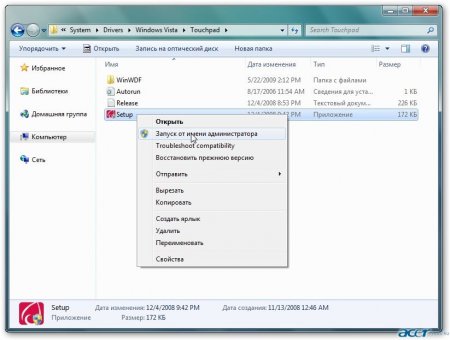
To install Launch Manager, right-click on Setup.exe and go to Properties:
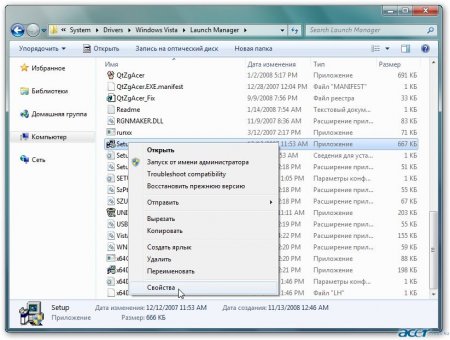
In the tab Compatibility select Windows Vista and press Apply:

After that run Setup.exe.
As a result, everything should be installed normally and work:
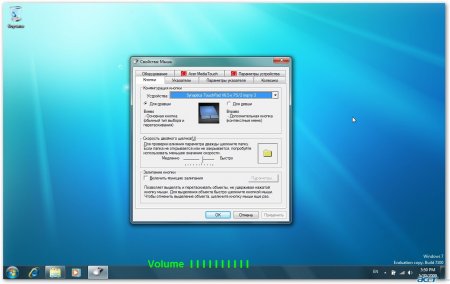

How to speed up Windows 7 is described in this article: Optimizing Windows
All questions about installation and Windows setup 7 we set not in the comments, but in the corresponding forum topic:
Edited: FuzzyL- December 5, 2012
Reason: Manual update. Version 2.1
Good afternoon, regular readers and first-time visitors. The reason for writing this article was an event that haunted me. I have been asked many times by mail to tell you how to install Windows 7 on a laptop or computer? By the way, for many years I had a good old version of Windows XP installed on my computer, I already talked about the specifics of installing this operating system in the article - "".
Despite its apparent simplicity, the installation of any operating system has its own subtleties and secrets. If you do not take them into account, then you may have to "reinstall Windows" more often than necessary. Agree that this option is not the most pleasant and it is better to do everything once, but as it should. Therefore, let's go directly to the question - how to properly install Windows 7 on any device: laptop or computer.
Attention! I think it will be very useful if you have the original distribution kit of Windows 7. After downloading from the Internet, you can pick up viruses or a non-working (buggy) system. To send you a download link, write to the mail [email protected]
There are several options for this:
- Installing Windows 7 from a disc. Just in this article, we will thoroughly touch on the issue of how to install Windows 7 from a disk via BIOS.
- Installing Windows 7 from a USB flash drive. To learn how to create bootable USB drive with Windows 7, read the blog post: "". This information is for those who want to know how to install Windows 7 from a USB stick.
In this article, I will show you how to install windows 7 from a disc. If you don't have a floppy drive or want to experiment a little with the installation, then follow the link above and learn how to install Windows 7 from a USB flash drive. I would like to draw your attention to the nuances associated with the choice of the distribution kit ( boot disk Windows 7).
Without going into issues of intellectual property protection, I want to draw your attention to the only point - try to use the disc or Windows image 7, original only. But it's best to use the original disc. Even with an obvious reluctance to spend your money, you can still get it, you just need to show a little imagination, since the Internet and friends are still there;).
I have taught all my friends for a long time that it is better to install from a normal disk than to beat the monitor and kick the system unit, for a large number of errors and constant freezes, after reinstall Windows... If there is no time or the Internet does not allow, then call your friends, I think that they will not mind borrowing the original Windows 7 distribution for a couple of hours.
So, let's proceed directly to installing Windows 7 on a computer. Most likely some operating system you already have it installed, so we will consider just this option. However, even if you set the "seven" to blank disk(on which there was no OS yet) the order of operations will be the same. Please be careful, then you will succeed!
Stage 1. Preparation.
In one of my articles, I recorded a video for my readers about the Windows installation plan. You do not need to complete the task!
If you want to make sure that Windows 7 is easy to install, after the article you will find a video where you will see everything step by step. But read the article first, as this video doesn't cover everything.
First of all, do not be lazy to go through the folders "My Documents", "My Pictures", "Desktop" and "Drive C: \". Most likely, you have documents saved there. Move them to another drive (for example, drive D: \). Otherwise, during installation, they will all be destroyed. Have experienced users there is such a wonderful rule - OS and programs on one disk, all information on another. It is very easy to follow this principle and also for safety reasons this method is necessary.
Then it doesn't hurt to check if Windows 7 can be installed on your computer. The easiest way to do this is to official page Microsoft at (). As a rule, most modern computers"Seven" is installed without problems. If system requirements Windows 7 comes to the computer, then move on.
Advice: if your driver disk is a little outdated, that is, you bought a computer or laptop 2-3 years ago, then it is best to download the latest drivers from the manufacturer's website.
The preparation is complete. We proceed directly to the installation.
Stage 2. Installation.
So now let's move from theory to practice. One of the most frequently asked questions from users is how to install Windows 7 correctly? To answer this question, you need to read the article further.
We reboot the computer and go into the BIOS. In order to get into it, you need to continuously press the key when starting the computer (they may differ, but most likely it will be) DELETE or F2. After that we find the tab "Advanced Options" and "Boot Device".
A small nuance: depending on your BIOS, the names of the tabs may differ. If you do not have tabs with such names, do not be discouraged, go to yours. You need a tab that contains the word "Boot" in its name.
By default, you will have a hard drive, if so, everything is correct.
We need to change the boot priority, namely, instead of the hard drive, select CDROM. In this tab, set the boot from the CD / DVD drive. To do this, select HDD and press Enter.
After that, we will have a choice. Move with arrows, select CDROM and press Enter.
After the changes, check that the CDROM has been exactly selected, otherwise further actions will not install Windows.
To save our changes, press the F10 key. To find out which key is responsible for saving, pay attention to the right or bottom of the screen. In my case, I have F10 - Save and Exit, just what I need.
You can also try pressing "F12" when turning on the computer, you will have access to a menu where you can select "CD-Rom". In this case, you do not need to go into the BIOS and make any changes.
When you press the F10 key, the computer will automatically restart. You will be prompted to press any key, which we do.
If you overslept this moment, then restart your computer manually and wait for the inscription to appear, which can be seen in the screenshot above.
After that, the immediate installation process will begin.
The information that I described above will help you install from a disk, but if you wanted to know how to install Windows from a USB flash drive, then you must first create a bootable USB flash drive (the link for this procedure is in the article above) and boot from it into Bios- e. The description below will be the same for any installation: from a USB flash drive or disk.
You will see a start window, which will ask you to select the installation language and regional settings (currency and default keyboard layout). I usually choose only the language, click the "Next" button.
In the next window, you need to make a choice between installing and restoring the system. Since we are installing it, we click Install.
The next is the traditional license agreement window.
Note. If you are prompted to choose the version of Windows 7, choose the largest of all available.
We agree with the license by checking the appropriate box and clicking "Next".
Now you need to decide on the type of installation. Without thinking twice, select "Full installation" and go to the window for selecting a disk for installation.
We already have a ready-made section for installation. Therefore, we choose it. If you forgot to copy the necessary data from the "C:" drive, then cancel the installation and save the data.
If you want to format the disk, you can do it in this window. To do this, select the required disk, it will be "C:" and press the "Disk settings" button.
Click "Format".
With a warning that all data will be destroyed, we agree by clicking on the "OK" button, because we looked through all the folders in advance and moved required files to another drive. We start the formatting process.
Note. For normal Windows work 7 create a 50 GB disk.
After a while, this operation will complete and the disk will be ready for installation. Select our disk, click "Next".
The process of copying files takes a long time. Therefore, you can drink tea or read a book. In any case, you have 20 minutes to do your business.
The computer will automatically restart. We do nothing, we just wait for all the data to be copied.
Solemn moment - Windows 7 launched for the first time on your computer. Now you need to enter your name.
In the next step, the installer will ask you to set a password to log on to the system. Do it or not do it - decide for yourself.
But again, I will give a little advice - we MUST PUT THE PASSWORD.
After that, you need to activate your version of Windows by entering the serial number. Where to get it depends on where you got the installation disc. Anyway, about availability serial number worth taking care of in advance. You can continue the installation without it, but Windows will work in this case for a 30-day period.
If you bought a laptop or computer with Windows 7, then look at the top system unit or at the bottom of the laptop, it should be on the stickers from Windows. Unless, of course, you or your kids put it in the trash bin;).
In the event that you do not have a product code, then you need to check the box "Automatically activate Windows when connected to the Internet." After that the "Next" button will become active. Otherwise, you will not be able to enter the just installed system Windows 7.
After entering the serial number, the installation program will offer to set the computer protection parameters. Select the "Postpone decision" item and set these parameters later, if necessary, after you finish the installation and make sure the system is working.
That's it, Windows 7 installation is complete. It remains only to install and configure the system at your own discretion.
Now you know how to install Windows 7 from a disc on a laptop or computer. I think that you will succeed or succeed. The first installation of Windows 7 will seem very difficult for you, but once you install it, you can easily repeat it without any fear.
P.S .: In order for you to see clearly how Windows 7 is installed, watch the video:
 Differences Between GPT and MBR Partition Structures
Differences Between GPT and MBR Partition Structures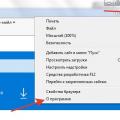 Wipe Internet Explorer cleanly
Wipe Internet Explorer cleanly Windows updates are downloaded but not installed
Windows updates are downloaded but not installed